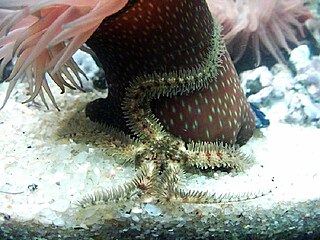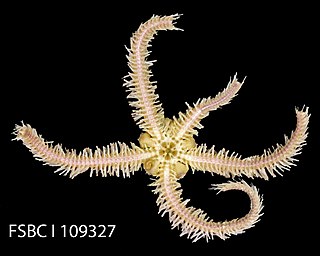
An echinoderm is any member of the phylum Echinodermata. The adults are recognisable by their radial symmetry, and include starfish, brittle stars, sea urchins, sand dollars, and sea cucumbers, as well as the sea lilies or "stone lilies". Adult echinoderms are found on the sea bed at every ocean depth, from the intertidal zone to the abyssal zone. The phylum contains about 7,000 living species, making it the second-largest grouping of deuterostomes, after the chordates. Echinoderms are the largest entirely marine phylum. The first definitive echinoderms appeared near the start of the Cambrian.

Crinoids are marine animals that make up the class Crinoidea. Crinoids that are attached to the sea bottom by a stalk in their juvenile form are commonly called sea lilies, while the unstalked forms, called feather stars or comatulids, are members of the largest crinoid order, Comatulida. Crinoids are echinoderms in the phylum Echinodermata, which also includes the starfish, brittle stars, sea urchins and sea cucumbers. They live in both shallow water and in depths as great as 9,000 meters (30,000 ft).

Brittle stars, serpent stars, or ophiuroids are echinoderms in the class Ophiuroidea, closely related to starfish. They crawl across the sea floor using their flexible arms for locomotion. The ophiuroids generally have five long, slender, whip-like arms which may reach up to 60 cm (24 in) in length on the largest specimens.

Bothriolepis was a widespread, abundant and diverse genus of antiarch placoderms that lived during the Middle to Late Devonian period of the Paleozoic Era. Historically, Bothriolepis resided in an array of paleo-environments spread across every paleocontinent, including near shore marine and freshwater settings. Most species of Bothriolepis were characterized as relatively small, benthic, freshwater detritivores, averaging around 30 centimetres (12 in) in length. However, the largest species, B. rex, had an estimated bodylength of 170 centimetres (67 in). Although expansive with over 60 species found worldwide, comparatively Bothriolepis is not unusually more diverse than most modern bottom dwelling species around today.
The Oegophiurida are an order of brittle stars, class Ophiuroidea.

The Ophiurida are an order of echinoderms within the class Ophiuroidea. It includes the vast majority of living brittle stars.
Ophiocanops fugiens is a living species in the brittle star family Ophiocanopidae. Though once considered to be the only one living species in this brittle star family, recent research has brought to light three specimens of Ophiocanops that differ substantially from O. fugiens. It has been regarded as the most primitive brittle star, close to Paleozoic forms, though other authors have disagreed with the view. Classification of O. fugiens is highly argued. Ophiocanops is usually placed in the order Oegophiurida or regarded as a genus incertae sedis or even given its own subclass Oegophiuridea. Some recent data suggest its relationship to the extant family Ophiomyxidae.

The Asterozoa are a subphylum in the phylum Echinodermata. Characteristics include a star-shaped body and radially divergent axes of symmetry. The subphylum includes the class Asteroidea, the class Ophiuroidea, and the extinct order Somasteroidea.

Ophiothrix fragilis is a species of brittle star in the order Ophiurida. It is found around the coasts of western Europe and is known in Britain as the common brittle star. It is also found along the coast of South Africa where it is known as the hairy brittle star.

Ophiocomina nigra, commonly known as the black brittle star or black serpent star, is a species of marine invertebrate in the order Ophiurida. It occurs in the north-eastern Atlantic Ocean, the North Sea, and the Mediterranean Sea.

Ophiothrix suensoni, Suenson's brittle star or the sponge brittle star, is a species of marine invertebrate in the order Ophiurida. It is found in the Caribbean Sea and Gulf of Mexico. It is included in the subgenus Acanthophiothrix making its full scientific name Ophiothrix (Acanthophiothrix) suensoni.

Ophiocoma scolopendrina is a species of brittle star belonging to the family Ophiocomidae. Restricted to life in the intertidal, they live in the Indo-Pacific. They can typically be found within crevices or beneath borders on intertidal reef platforms. Unlike other Ophiocoma brittle stars, they are known for their unique way of surface-film feeding, using their arms to sweep the sea surface and trap food. Regeneration of their arms are a vital component of their physiology, allowing them to efficiently surface-film feed. These stars also have the ability to reproduce throughout the year, and have been known to have symbiotic relationships with other organisms.
Pelanechinus is an extinct genus of sea urchins in the order Echinothurioida. It is placed in the family Pelanechinidae and is in the stem group of echinoids.

Ophionereis reticulata, the reticulated brittle star, is a brittle star in the family Ophionereididae. It is found in shallow parts of the western Atlantic, Caribbean Sea and Gulf of Mexico.

Ophiothrix angulata, the angular brittle star, is a species of marine invertebrate in the order Ophiurida. It is found in the warm waters of the western Atlantic Ocean, the Caribbean Sea and the Gulf of Mexico.

Astrobrachion adhaerens is a basket star in the Euryalidae family. Along with A. constrictum, it is one of only two species in the genus Astrobrachion. Both species live in association with soft corals in moderately deep water. It is endemic to the west, north and east coasts of Australia, the Kermadec Islands and Lord Howe Island.
Acrocnida brachiata, the sand burrowing brittlestar, is a species of brittle star in the family Amphiuridae. It occurs on the seabed in the northeastern Atlantic Ocean and the North Sea, living semi-buried in the sand with only its arm tips projecting.

Ophiomusa is a genus of echinoderms belonging to the family Ophiolepididae that includes: sea urchins, sand dollars and sea cucumbers. Ophiurida are similar to starfish; they both have a central disc and five arms sprouting from the disc. One of the main distinguishing factors of an Ophiuroid is its arms; the arms of an Ophiurida are longer, thinner, and distinctly separated in comparison to those of a sea star.

Melusinaster is a genus of basket stars from the Jurassic period described by Thuy and Stöhr in 2018. Fossil specimens from areas throughout Germany were used to describe the genus. The individuals described with small ophiuroids with arched, crescent-shaped arm plates, articulations in the spine made of muscle and nerve openings, and no tubercles or spurs on the outer surfaces of the arm plates.

Villebrunaster is an extinct genus of starfish-like animal belonging to Asterozoa that lived around 480 million years ago during Early Ordovician Period in modern-day southern France and Morocco. As of 2022, it contains two species, namely V. thorali and V. fezouataensis. V. thorali was described in 1951 and V. fezouataensis was described in 2021. Villebrunaster represents one of the oldest members of asterozoans, and perhaps, according to a description in 2021, the earliest divergent stem-group of Asterozoa.















